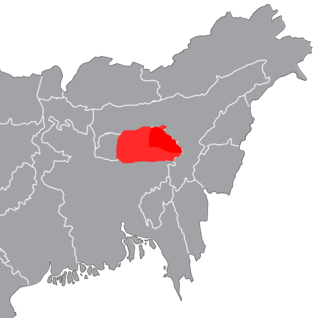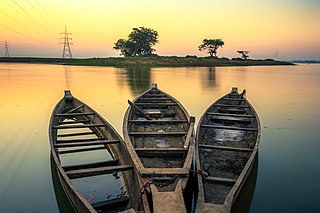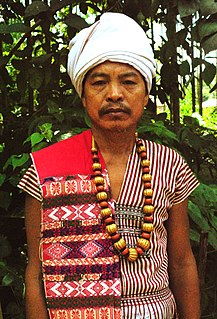Related Research Articles

Khasi is an Austroasiatic language spoken primarily in Meghalaya state in India by the Khasi people. It is also spoken by a sizeable population in Assam and Bangladesh. Khasi is part of the Austroasiatic language family, and is related to Khmer, Palaung, Vietnamese and Mon languages of Southeast Asia, and the Munda and Nicobarese branches of that family, which are spoken in east–central India and in the Nicobar Islands, respectively.
The Hmar language or Khawsak ṭawng belongs to the Kukish branch of the Sino-Tibetan family of languages. The speakers of the language are also known as Hmar. According to the official 2011 Census of India, there are 29,268 Hmar/Khawsak speakers in Assam, 48,375 in Manipur, 1,700 in Meghalaya, 18,587 in Mizoram although Majority of the Hmars in Mizoram speak Duhlian (Mizo).

Ri Bhoi is an administrative district in the state of Meghalaya in India. The district headquarters are located at Nongpoh. The district occupies an area of 2378 km² and has a population of 258,840. As of 2011 it is the second least populous district of Meghalaya, after South Garo Hills.

Kamrup Rural district, or simply Kamrup district, is an administrative district in the state of Assam in India formed by dividing the old Kamrup district into two in the year 2003; other being Kamrup Metropolitan district, named after region it constitute. The district, along with Nalbari, Barpeta, Kamrup Metropolitan, Bajali and Baksa districts have been created from the Undivided Kamrup district.

The Karbis, mentioned as the Mikir are one of the major ethnic communities in Northeast India mostly concentrated in the hill district of Karbi Anglong of Assam.
Garo, also referred to by its endonym A·chikku, is a Sino-Tibetan language spoken in India in the Garo Hills districts of Meghalaya, some parts of Assam, and in small pockets in Tripura. It is also spoken in certain areas of the neighbouring Bangladesh. According to the 2001 census, there are about 889,000 Garo speakers in India alone; another 130,000 are found in Bangladesh.
The Dimasa language is a Sino-Tibetan language spoken by the Dimasa people in Northeastern part of India, in the states of Assam and Nagaland. The Dimasa language is known to Dimasas as "Grao-Dima" and it is similar to Boro, Kokborok and Garo language of India.
Amri or AMRI may refer to:

The Karbi language is spoken by the Karbi people of Northeastern India.
Tiwa (Lalung) is an ethnic group mainly inhabiting the states of Assam and Meghalaya in northeastern India. They are also found in some areas of Arunachal Pradesh, Manipur and Nagaland. They are recognized as a Scheduled tribe within the State of Assam. They were known as Lalungs in the Assamese Buranjis and in Colonial literature and in the Constitution of India, though members of the group prefer to call themselves Tiwa. Some of their neighbours still call them Lalung.
Rengma, or Southern Rengma, is an Angami–Pochuri language spoken in Nagaland, India.
Biate is a Sino-Tibetan language spoken by the Biate people in several parts of Northeast India: in Meghalaya, Assam, Mizoram, Manipur and Tripura. Biate is pronounced as Bia-te.
Sakachep also known as Khelma, is a Central Kuki-Chin-Mizo language of Northeast India. Dialects are Khelma, Thangachep, and Sakachep (Ethnologue). VanBik (2009) classifies Sakachep as closely related to Hmar.
Vaiphei is a Kuki-Chin language of India spoken in Mizoram, Manipur, Assam, Meghalaya, and Tripura. The dialect spoken in Manipur exhibits a least partial mutual intelligibility with the other Mizo/Kukish dialects of the area including Thadou, Hmar, Paite, Simte, Kom and Gangte languages.
Gangte is a Kuki-Chin language of Northeastern India. Speakers are found primarily in Manipur and adjacent areas of Meghalaya and Assam. The language appears to be homogeneous with no known dialectal variation and exhibits at least partial mutual intelligibility with the other Chin-Kuki-Mizo dialects of the area including Thadou, Hmar, Vaiphei, Simte, Kom and Paite languages. There are a few speakers across the border in Burma.
Tiwa (Lalung) is a Tibeto-Burman (Sino-Tibetan) language spoken by the Tiwa people in Assam and Meghalaya in North East India. Tiwa language is similar to Boro, Dimasa, Kokborok and Garo language of India.
Rabha is a Sino-Tibetan language of India. The two dialects, Maituri and Rongdani, are divergent enough to cause problems in communication. According to U.V. Joseph, there are three dialects, viz. Róngdani or Róngdania, Mayturi or Mayturia and Songga or Kocha. Joseph writes that "the Kocha dialect, spoken along the northern bank of the Brahmaputra, is highly divergent and is not intelligible to a Róngdani or Mayturi speaker". Joseph also writes that "[t]he dialect variations between Róngdani and Mayturi, both of which are spoken on the southern bank of the Brahmaputra, in the Goalpara district of Assam and belong to the northern slopes of Meghalaya, are minimal". He concludes the paragraph on dialectal variation with: "The Róngdani-Mayturi dialectal differences become gradually more marked as one moves further west".
Wancho is a Konyak language of north-eastern India. Wancho is spoken in 36 villages of southeastern Longding district, Tirap district, Arunachal Pradesh, as well as in Assam and Nagaland (Ethnologue). Alternate names include Banpara Naga, Joboka, Jokoba.
Karbi language is officially written in Roman script in Karbi Anglong and Dima Hasao districts of Assam, Meghalaya and Arunachal Pradesh. However, in Kamrup district of Assam prefer mostly the Assamese script.
The East Karbi Anglong district is a new district formed out of the existing Karbi Anglong District of Assam in 2016. Diphu is the headquarter of the newly formed district. The district is a part of Karbi Anglong Autonomous Council, Diphu and it is administered according to the Sixth Scheduled of the Indian Constitution.
References
- ↑ Amri at Ethnologue (18th ed., 2015) (subscription required)